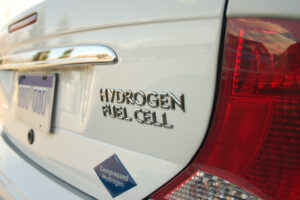
Panelists on electric & hydrogen power: ‘We’re going to need both’
By onMarket Trends | Technology
Hydrogen proponents discussed how fuel cell electric vehicles (FCEVs) could complement electric vehicles (EVs) Thursday as the push to advance zero-carbon transportation grows.
Jackie Birdsall, senior engineering manager for Toyota’s fuel cell integration group, and Bernd Heid, senior partner at McKinsey & Co., made the comments while participating in an Automotive News-hosted online panel.
“I think we will see in the next year that we will need both technologies,” Heid said. “The interesting part is that it’s not only dependent on the propulsion technology of the powertrain, but it also has to do with the infrastructure. And we will see that two infrastructures will be cheaper to society than if we just do all-electric infrastructure.”
Birdsall agreed, saying the switch to zero-emission vehicles can’t be accomplished with a single approach.
“Hydrogen and fuel cell electric vehicles are complementary,” she said. “There’s two different use cases. Our job is to give these zero-emission technologies, to make them available to the customer, and then the customer can choose the application or the powertrain that best suits their lifestyle [and] that best suits their fleet’s needs.”
Birdsall added: “We need to invest in the infrastructure equally for both battery electric and for fuel cell electric vehicles so that they can both succeed and both be available because in reality, we’re going to need both if we are going to really achieve our decarbonization goals.”
The panelists said that FCEVs might be a better option for those who don’t have access to at-home EV charging stations and need a longer range, while EVs might be a preferred choice for those making short-distance commutes.
“It’s not a race against these two technologies,” Birdsall said. “It’s a race against carbon and we really need to decarbonize as quickly as we possibly can to get there.”
Heid detailed how both technologies will be needed in the commercial space as well, saying that while FCEVs would be a cheaper option for long-haul truck fleets, EVs might be more practical for trucks making local deliveries.
“This is not a competition of one over the other,” he said. “This will be a coexistence of multiple technologies.”
The feasibility of hydrogen for the long-haul transport sector was put to the test recently when Hyzon Motors Inc. completed its first commercial demonstration of a liquid hydrogen FCEV.
The 540-mile demonstration was hailed by Hyzon as an example of how hydrogen could become an “economical approach to long-range zero-emission trucking.”
Birdsall, who lives in Los Angeles, also discussed the ease she’s experienced refueling her Toyota Mirai, which she said takes less than five minutes and can be done at any of the three fueling hydrogen stations near her home.
Heid said more infrastructure is needed to make stations accessible to those living in both rural and urban settings.
Right now, he said there are just over 100 hydrogen refueling stations available in the U.S. To achieve the level of convenience customers have been accustomed to, he said between 2,000 and 3,000 additional stations are needed.
“For a country like the U.S., that is not a lot,” he said, adding that careful planning will be necessary to determine where the additional stations should be placed.
Right now, California lawmakers are trying to find a solution to provide more hydrogen fuel station access for FCEVs.
CalMatters, a nonprofit news group, reported that as California steers away from ICE vehicles, lawmakers are arguing about the role FCEVs will play in the future, down to how much money they’ll spend on hydrogen fuel stations.
A lobbying group for hydrogen supporters and suppliers, including Chevron, Shell, and Toyota, is seeking a designated 30% share of money from the state Clean Transportation Program, amounting to $300 million over the next decade, according to CalMatters. And the California Energy Commission has spent $202 million on hydrogen fueling stations.
Only two hydrogen models are available, the Mirai and Hyundai Nexo, although other OEMs are working on either concept cars or the launch of FCEVs.
Images
Main image: gchutka/iStock
